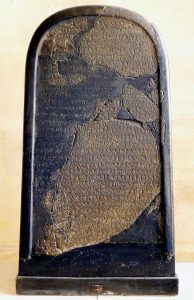
This inscription pays tribute to Mesha the king of Moab, celebrating his great building works and victories over the kingdom of Israel during the reign of Ahab, son of Omri. It is the earliest known mention of the kingdom of Israel to date.
Two neighbouring tribes, the Gadites and the Dibonites co-existed in the southern Transjordanian Mishor (plateau), an area that changed hands between them over the years.
Dhiban, ancient Dibon, where the stele was found, was the capital of the kingdom of Moab, located on the left bank of the Dead Sea.
It is made of black basalt stone 1.15 meters high and 60-68 centimeters wide. Discovered in 1868 at Dhiban in Jordan and is written in Moabite (a West Semitic language) . It is presently located at the Louvre Museum, Paris.
THE SCRIPTURES IN THE MESHA STELE
● [Mesha Stele]: I am Mesha, son of Kemosh[-yatti], the king of Moab, the Dhibanite.
King Mesha of Moab is mentioned in 2 Kings as paying a tribute to the king Yisra’el
2 Kings 3:4
And Meysha sovereign of Mo’aḇ was a sheep-breeder, and he paid the sovereign of Yisra’el one hundred thousand lambs and the wool of one hundred thousand rams.
● [Mesha Stele]: And I made this high-place for Kemosh in Qarcho…
The Moabite national god Kemosh (Chemosh) is mentioned in various places in the Scriptures
Numbers 21:29 Woe to you, Mo’ab! You have perished, O people of Kemosh! He has given his sons as fugitives, and his daughters into captivity, to Sihon the sovereign of the Amorites. [see: Judges 11:24; 1 Kings 11:7, 33; 2 Kings 23:13; Jeremiah 48:7, 13, 46.]
● [Mesha Stele]: Omri was the king of Israel…
The rise of Omri from commander of the army to king of Israel is recorded in 1 Kings chapter 16. Verse 23 describes how he becomes king
1 Kings 16:23
In the thirty-first year of Asa sovereign of Yehudah, Omri became sovereign over Yisra’el, and reigned twelve years. He reigned six years in Tirtsah.
The stele also mentions Gad and Nebo, places that are described in the Scriptures
● [Mesha Stele]: And the men of Gad lived in the land of Atarot…
● [Mesha Stele]: And Kemosh said to me, “Go, take Nebo from Israel.”
Mesha’s revolt against Israel is recorded in chapter 3 of 2 Kings. Israel and her allies Judah and Edom try to quash the revolt. The timing of this revolt is in dispute by some scholars as the stele mentions the ‘son of Omri’ who was Ahab while the Scriptures tell us that it took place during the time of Yehoram (Jehoram) the grandson of Omri. This discrepancy is reconciled by the fact that ‘son of…’ can literally mean son and can also mean ‘descendant’ in ancient near east language.
The stele has also the earliest known mention of Yahweh, the Almighty of Israel.
The Mesha stele is one of the most important Biblical artifacts discovered to date.
Sources:
K. C. Hanson; A Caubet; Jewishvirtuallibrary.org; Dr. Yigal Levin; biblehub.net; wikipedia.
Unless otherwise noted, all Scripture is taken from The Scriptures,
Copyright by Institute for Scripture Research.
Used by permission.
Description: material, height and width
Created
Date Discovered
Language
Translation
Present Location